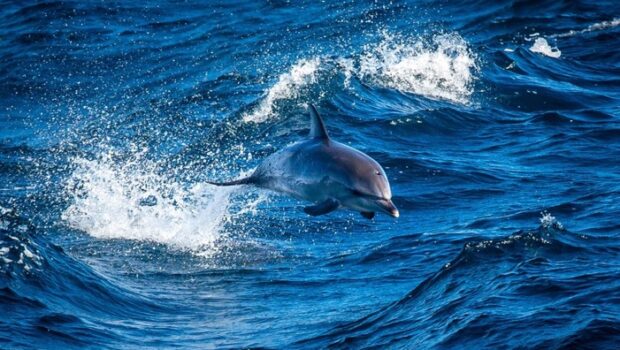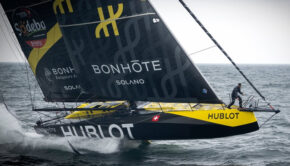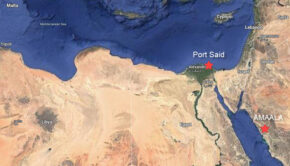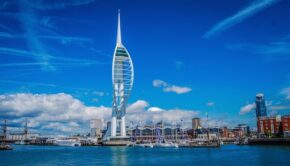The Ocean Race: Respecting wildlife
Published on April 29th, 2023
There are numerous exclusion zones that The Ocean Race teams must avoid when racing. Some are for commercial shipping, others to protect the wildlife.
Each leg of The Ocean Race has featured some sort of exclusion zone. Leg 3, with competitors racing deep in the southern latitudes, had a long exclusion to the south, in place to keep the teams from pushing into areas with dangerous icebergs.
In Leg 4 from Brazil to the USA, Race Director Phil Lawrence and his team have outlined a number of exclusion zones. Lawrence says the exclusion zones fall into four broad categories:
— Areas with high levels of hazards or marine traffic – the oilfields off the coast of Brazil fall into this category and featured in the first days of the leg;
— Areas with high levels of protected marine life – the whale breeding grounds on the Abrolhos Bank off the coast of Brazil are an example of an area the boats have routed around (see more below);
— Areas with specific hazards – later on this leg, the exclusion zone off the northeast coast of Brazil is in place to keep the boats away from debris that comes out of the Amazon River Delta;
— Designated shipping lanes where traffic can only travel in one direction – there is a zone like this on the approach to Rhode Island.
In addition to reducing the risk to the fleet and to marine life, exclusion zones often force tactical decisions as teams must make a decision that involves a commitment to either stay with the group (lower risk / low potential reward) or try to gain separation (higher risk / higher potential reward). Early in a leg, the teams will generally take the lower risk option unless they truly believe they can make a gain by separating.
While some of the exclusion zones are to avoid dangerous commercial shipping activities, others are designed to protect the boats and marine life from a dangerous encounter.
Damian Foxall, the Sustainability Program Manager for 11th Hour Racing Team is also on the Marine Mammal Advisory Group. He has joined the team as trimmer on board for Leg 4, and is a hugely experienced sailor in the race. Over the years, he has gained an appreciation for the ocean as more than just the field of play for The Ocean Race:
“(It’s a privileged) opportunity to be out here racing on the ocean and seeing the amazing bird life and marine mammals. But this also has a risk to it – a risk in that these boats go so fast, and with the foils and the keels, there is the risk of endangering a marine mammal. So the Race puts in place exclusion zones and we are working our way around the Abrolhos Exclusion Zone right now.
“In the Marine Mammal Advisory Group we have worked with The Ocean Race to integrate a proper risk assessment for marine mammals and marine life for each leg of the course. This involves assessing where the high levels of the marine mammal population are and what zones are best avoided.
“We have one here called the Abrolhos Banks which is one of the zones where up to 25,000 Southern Right Whales and Humpbacks come from Antarctica to where the warmer waters are, and to breed. We are a month away from this activity, but just to be safe, the organizers have defined this exclusion zone for us to sail around.
“The exclusion zones are very specific to each leg, and in Leg 4 of this edition of the race there are quite a number, (including some) due to the high level of whales that we have along the coast.
“When we will be sailing into the finish at Newport, Rhode Island, we are in the territory of the very endangered population of Northern Right Whales. Luckily we are also out of season and they have moved away from the waters outside Narragansett Bay.
“The area has very good underwater live tracking systems, with flyovers, underwater drones and ships all reporting sightings. And the live tracking system is updated all the time. If the mammals are seen as we approach Newport, we will be informed and the Race Organisers will adjust our race course accordingly. Right now, we are doing a few extra miles for the whales and no one has any complaints about that.”
Lawrence says there will be more exclusion zones on Leg 5, the transatlantic leg, especially on the departure from Newport.
The current leg of The Ocean Race is expected to take up to 17 days, with an ETA around May 9th or 10th.
Leg Four Rankings at 14:00 UTC*
1. Holcim-PRB, distance to finish, 4593.9 nm
2. 11th Hour Racing Team, distance to lead, 0.4 nm
3. Biotherm, distance to lead, 9.9 nm
4. Team Malizia, distance to lead, 10.5 nm
5. GUYOT environnement, distance to lead, 24.1 nm
* Until the fleet uniformly aims along the course route, the ranking may be misleading.
Race details – Route – Tracker – Teams – Content from the boats – YouTube
Overall Leaderboard (after 3 of 7 legs)
1. Team Holcim-PRB — 19 points
2. Team Malizia — 14 points
3. 11th Hour Racing Team — 13 points
4. Biotherm — 10 points
5. GUYOT environnement – Team Europe — 2 points
IMOCA: Name, Design, Skipper, Launch date
• Guyot Environnement – Team Europe (VPLP Verdier); Benjamin Dutreux (FRA)/Robert Stanjek (GER); September 1, 2015
• 11th Hour Racing Team (Guillaume Verdier); Charlie Enright (USA); August 24, 2021
• Holcim-PRB (Guillaume Verdier); Kevin Escoffier (FRA); May 8, 2022
• Team Malizia (VPLP); Boris Herrmann (GER); July 19, 2022
• Biotherm (Guillaume Verdier); Paul Meilhat (FRA); August 31 2022
The Ocean Race 2022-23 Race Schedule:
Alicante, Spain – Leg 1 (1900 nm) start: January 15, 2023
Cabo Verde – ETA: January 22; Leg 2 (4600 nm) start: January 25
Cape Town, South Africa – ETA: February 9; Leg 3 (12750 nm) start: February 26
Itajaí, Brazil – ETA: April 1; Leg 4 (5500 nm) start: April 23
Newport, RI, USA – ETA: May 10; Leg 5 (3500 nm) start: May 21
Aarhus, Denmark – ETA: May 30; Leg 6 (800 nm) start: June 8
Kiel, Germany (Fly-By) – June 9
The Hague, The Netherlands – ETA: June 11; Leg 7 (2200 nm) start: June 15
Genova, Italy – The Grand Finale – ETA: June 25, 2023; Final In-Port Race: July 1, 2023
The Ocean Race (formerly Volvo Ocean Race and Whitbread Round the World Race) was initially to be raced in two classes of boats: the high-performance, foiling, IMOCA 60 class and the one-design VO65 class which has been used for the last two editions of the race.
However, only the IMOCAs will be racing round the world while the VO65s will race in The Ocean Race VO65 Sprint which competes in Legs 1, 6, and 7 of The Ocean Race course.
Additionally, The Ocean Race also features the In-Port Series with races at seven of the course’s stopover cities around the world which allow local fans to get up close and personal to the teams as they battle it out around a short inshore course.
Although in-port races do not count towards a team’s overall points score, they do play an important part in the overall rankings as the In-Port Race Series standings are used to break any points ties that occur during the race around the world.
The 14th edition of The Ocean Race was originally planned for 2021-22 but was postponed one year due to the pandemic, with the first leg starting on January 15, 2023.
Source: TOR










 We’ll keep your information safe.
We’ll keep your information safe.